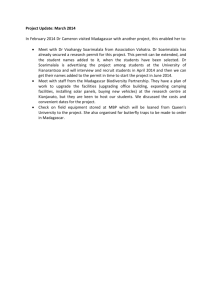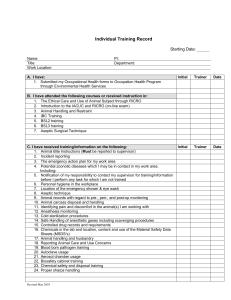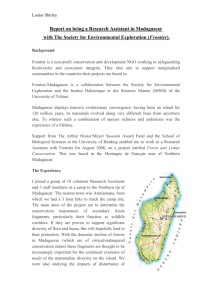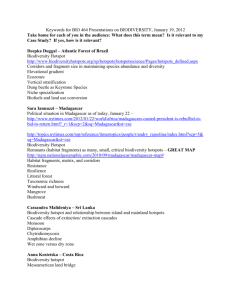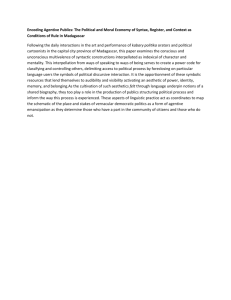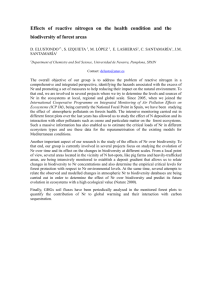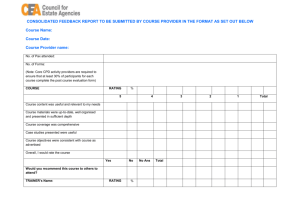Section II
advertisement
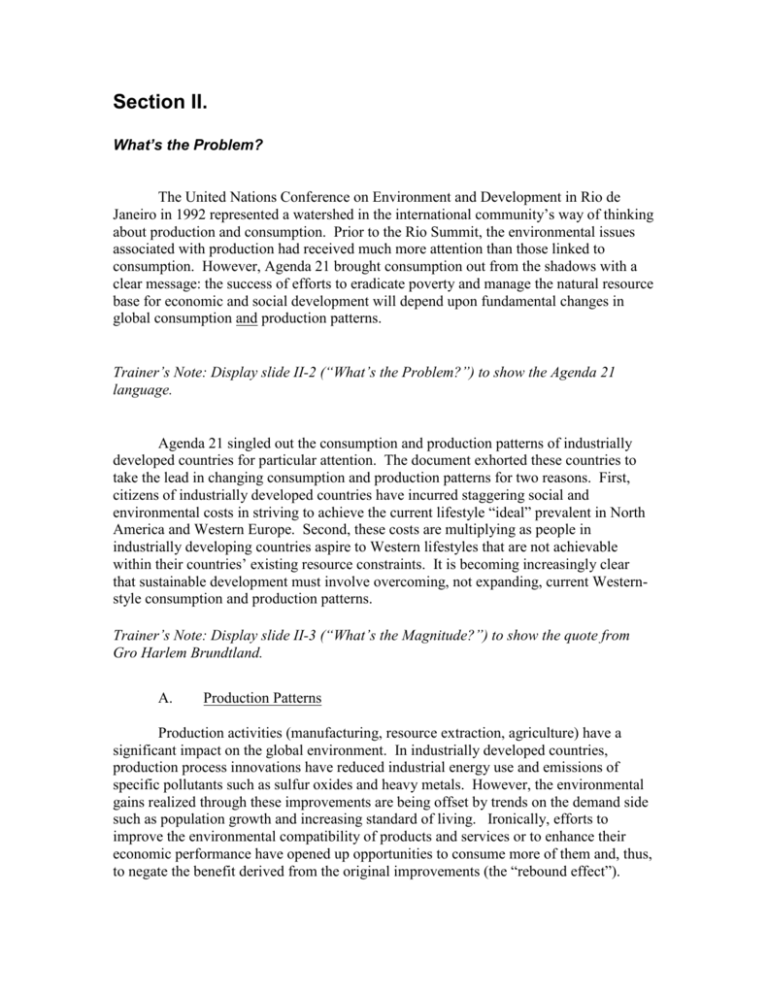
Section II. What’s the Problem? The United Nations Conference on Environment and Development in Rio de Janeiro in 1992 represented a watershed in the international community’s way of thinking about production and consumption. Prior to the Rio Summit, the environmental issues associated with production had received much more attention than those linked to consumption. However, Agenda 21 brought consumption out from the shadows with a clear message: the success of efforts to eradicate poverty and manage the natural resource base for economic and social development will depend upon fundamental changes in global consumption and production patterns. Trainer’s Note: Display slide II-2 (“What’s the Problem?”) to show the Agenda 21 language. Agenda 21 singled out the consumption and production patterns of industrially developed countries for particular attention. The document exhorted these countries to take the lead in changing consumption and production patterns for two reasons. First, citizens of industrially developed countries have incurred staggering social and environmental costs in striving to achieve the current lifestyle “ideal” prevalent in North America and Western Europe. Second, these costs are multiplying as people in industrially developing countries aspire to Western lifestyles that are not achievable within their countries’ existing resource constraints. It is becoming increasingly clear that sustainable development must involve overcoming, not expanding, current Westernstyle consumption and production patterns. Trainer’s Note: Display slide II-3 (“What’s the Magnitude?”) to show the quote from Gro Harlem Brundtland. A. Production Patterns Production activities (manufacturing, resource extraction, agriculture) have a significant impact on the global environment. In industrially developed countries, production process innovations have reduced industrial energy use and emissions of specific pollutants such as sulfur oxides and heavy metals. However, the environmental gains realized through these improvements are being offset by trends on the demand side such as population growth and increasing standard of living. Ironically, efforts to improve the environmental compatibility of products and services or to enhance their economic performance have opened up opportunities to consume more of them and, thus, to negate the benefit derived from the original improvements (the “rebound effect”). More than 1,000 cleaner production demonstration projects have been launched, but their multiplier effect has been poor. There is still much work to be done to mainstream sustainable production practices everywhere. The concept of cleaner production must be translated from the manufacturing sector, where it germinated, to the increasingly important service sector. Cleaner production efforts must expand beyond their historic focus on urban issues to address improvements in rural production activities such as agriculture, dairy farming, mining, forestry and fisheries. Innovations in these areas are critical to protect and manage natural resources as well as to sustain the livelihood of rural communities. B. Consumption Patterns Current consumption patterns pose a problem because of two seemingly contradictory traits – overconsumption and underconsumption. In the aggregate, worldwide consumption has increased dramatically. At the same time, millions of people are not consuming enough to meet their basic needs. Both trends are placing enormous stress on the global environment. The past several decades have seen an extraordinary expansion of the global economy and a corresponding explosion in consumption. Global consumption expenditure has grown by an average of 3% per year since 1970. From 1973 to 1998, it doubled in real terms to reach US $24 trillion. Some of this growth in consumption has been essential to human development (food, shelter, clean water, etc.). However, much of this spending has been for “wants” rather than “needs.” Trainer’s Note: Display slide II-4 (“Consumption: Meeting Basic Needs?”) to show the contrast in spending on luxuries vs. necessities. Like wealth, privilege, and power, consumption is distributed inequitably. The richest quintile of the world’s population accounts for 86% of total private consumption expenditures. By contrast, the poorest quintile accounts for 1.3%. It has been estimated that an average person in North America consumes almost 20 times as much as a person in India or China and 60-70 times more than a person in Bangladesh (Brundtland, 1994). The distribution of consumption is also unequal within countries. The United States, with one of the highest average incomes, has the highest population percentage experiencing human poverty. In Mexico, almost all of the richest fifth – and almost none of the poorest fifth – have access to sanitation. (UNEP, 2001) Although average per capita consumption has increased in many parts of the world, it has not risen for everyone. From 1973 to 1998, the consumption of an average African household decreased by 20% - even while per capita consumption in East Asia grew by a staggering 6.1% annually. Today, over one billion people need to increase their consumption to meet their basic needs - including 100 million people in industrially developed nations. Trainer’s Note: Display slide II-5 (“Consumption (Mostly) Grows…”). How is underconsumption an environmental problem? Poverty and lack of infrastructure impair the capacity of less developed countries to look after their own people and natural environments. People who do not consume enough to meet their basic needs are often forced to make decisions for short-term survival that have negative longterm environmental impacts. Poor fishers in Southeast Asia practice cyanide fishing, threatening reef ecosystems in the process. Poor farmers in Sub-Saharan Africa burn trees to gain land for planting rice. The destruction of forests has accelerated erosion and desertification, increasing poverty and deprivation – often without yielding new productive land. The readings at the end of this Section include a poignant illustration of this phenomenon in Madagascar. C. Environmental Impacts What is the impact of current consumption and production patterns on the environment? They are depleting many nonrenewable resources, generating pollution and waste that exceed the planet’s sink capacities to absorb and convert them, and contributing to the deterioration of renewable resources such as water, soil, and forests. Trainer’s Note: Refer to slide II-6 (“Key Environmental Impacts from Unsustainable Consumption”) to give specific examples of the environmental effects of unsustainable consumption. When fish stocks are depleted or forests clear-cut, it is easy to see the impact of consumption patterns on the environment. But consumption patterns also affect the environment in many less obvious ways. Energy, water and raw materials are required to make the products that consumers purchase. Soil and ecosystems are disturbed to extract resources and convert land to productive use. The production, use, and disposal of products all contribute pollution and waste to the environment. Trainer’s Note: Refer to slide II-7, “How Consumption Affects the Environment,” to demonstrate the inputs and outputs associated with the average daily consumption of one individual in the United States. Point out the magnitude of water used and waste generated. In 1998, the World Wildlife Fund developed an index of “Consumption Pressures” to attempt to measure the burden placed on natural ecosystems by human activity. The index looked at six categories of data from 152 countries to calculate consumption pressure per person and per country. The index is an interesting tool to compare the environmental effects of consumption among different countries. Trainer’s Note: Display slide II-8 (“Consumption Pressure Index”). The environmental effects of current production and consumption patterns are neither localized nor equitably distributed. For example, while deforestation is concentrated in developing countries, much of it has taken place to meet industrialized countries’ demand for wood and paper. Similarly, it is predicted that climate change, which is largely a result of intensive fossil fuel use in industrial societies, will most adversely affect countries such as Bangladesh and Pacific island nations that have not significantly participated in (or benefited from) industrialization. How can we consume and produce in an environmentally sustainable way? It is possible for production to deliver products that improve the basic quality of life for many people with minimal environmental effect. Similarly, it is possible for people to consume resources in a way that do not jeopardize the environment and do not stimulate the demand for products that are unsustainably produced. In order to achieve these goals, we must abandon our approach to consumption and production as separate systems. The next Section introduces tools for looking at a single integrated system focused on products, which represent the nexus between consumption and production. REFERENCES and KEY RESOURCES: UNDP, Human Development Report, 1998. WWF, Consumption Pressures, 1998. UNEP, Consumption Opportunities, 2001. ICEBREAKER EXERCISE Trainer’s Note: Display slide II-9 (“Sustainable Production/Consumption Icebreaker”). Ask participants to review the list of symptoms of unsustainable consumption from UNEP’s Africa Roundtable Report, excerpted below. Ask them as they read it to think about whether they have seen some or all of these symptoms in their home country. “Serious environmental, economic and social challenges facing Africa today include: Increasing social and economic inequality and its associated impact on the environment and an accelerating pace of economic globalisation and its environmental impact on Africa. Population growth Rural – urban migration Lacking infrastructure Pollution of fresh water resources due to mining and urban waste. Land degradation caused by variety of factors such as agriculture, mining, overgrazing, recurrent bush fires and population pressures. Deforestation due to increasing pollution and the consequent demand for agricultural land and urban demand for forest products. Loss of biodiversity due to forestation, firewood harvesting, slash and burn agriculture, mining activities, bush fires and the overexploitation of marine resources.” UNEP DTIE/ROA, Background Paper: Workshop on Sustainable Consumption in Africa, Nairobi, Kenya, 2000. Trainer’s Note: Tell participants, we have just seen some examples of unsustainable behavior or activities from one region of the world. Now let us look at sustainable activities and/or behaviors. Ask participants to give examples, from their experience, of sustainable production and then sustainable consumption. Record their comments on a flip chart. After participants have finished brainstorming, Display slide II-10. Briefly review their inputs. Highlight common ideas or themes. Supplemental Reading II-1. UNDP, Human Development Report, 1998, pp. 1-13. http://hdr.undp.org/reports/global/1998/en/pdf/hdr_1998_overview.pdf II-2. The World Bank and Oxford University Press, Sustainable Development in a Dynamic World: Transforming Institutions, Growth, and Quality of Life (World Development Report 2003), p. 16 http://econ.worldbank.org/files/17958_WDR_2003_chp_8_web.pdf Supplemental Reading II-2: Poverty and biodiversity in Madagascar Excerpted from the World Bank and Oxford University Press, Sustainable Development in a Dynamic World: Transforming Institutions, Growth, and Quality of Life (World Development Report 2003), p. 16 Madagascar’s biodiversity is among the richest and most unusual in the world, an asset difficult to value in monetary terms but with great potential to support ecotourism and perhaps bioprospecting industries. Of its 12,000 plant species, 85 percent are found only on Madagascar. Its 32 endemic lemur species are an attraction for ecotourists. Alkaloids extracted from its rosy periwinkle plant form the basis for some of the most effective cancer treatment drugs, achieving a 90 percent remission rate against childhood leukemia. Yet over the past 40 years, Madagascar has liquidated about half its forests, which contain the overwhelming majority of its biodiversity assets, without realizing offsetting gains in other assets. The country has fallen deeper into poverty, with its GDP per capita falling from $383 (in 1995 dollars) in 1960 to $246 today. In 1997, 16 percent of children died before age five. What happened? Agricultural productivity stagnated while population tripled. Madagascar’s people depend heavily on rice and a few other staple crops. In 1960 average rice productivity was 1.8 tons a hectare—about the same as Indonesia, and much more than the 1 ton a hectare average in Mali. By 2000 productivity had doubled in Mali and more than doubled in Indonesia, but it was almost unchanged in Madagascar. Static productivity—despite a substantial increase in irrigated rice area— reflects in part the implosion of the nation’s road network, which fell from 55,000 kilometers in 1960 to 33,000 in 2000. It reflects also a low and declining rate of fertilizer use: only 4 kilograms per hectare, against a Sub-Saharan average of 12 and a developing country average of 96 (WRI 2000). Meanwhile, population grew from 5.4 million to 15.5 million. The combination of an expanding population and stagnant productivity generated pressures for agricultural expansion through forest conversion. Small farmers expanded slash-and-burn cultivation of rice into forest lands officially belonging to the state. The practice is attractive to farmers because of its low labor and input requirements and relatively attractive yields in the first two years. But yields rapidly decline to less than half a ton per hectare after a year or two. Subsequently, the land is used for even lower productivity uses, such as cattle, or it is abandoned. In drier parts of the country, grazing and fuelwood extraction spur forest degradation. So, while 115,000 square kilometers of forest have been lost since 1960, the area under cultivation for staple crops has expanded by only 15,000 square kilometers. Forest destruction has not only failed to yield new productive land; it has degraded the productivity of existing farmlands and infrastructure. Denuded hillsides are easily eroded: 130,000 hectares of irrigated land have sustained damage or are threatened by sediment. Sediment also clogs hydropower facilities and threatens freshwater and marine ecosystems. Madagascar hopes to alleviate poverty and reduce pressure on its biodiversity by boosting agricultural productivity. Improving roads in agriculturally productive areas may increase farmer revenues, reduce fertilizer prices, promote intensification, and absorb labor—reducing incentives for farmers to migrate to the forest frontier. In addition, transferring property and management rights of natural resources to local communities is generating incentives for more sustainable use and conservation of these resources. The country also aims to scale up promising sustainable agricultural technologies, such as conservation tillage, that better protect natural resources and that have the capacity to improve profitability. Expansion of the tiny industrial sector may also relieve pressure on the land. In the medium to long run, Madagascar’s unique natural assets may provide the basis for a lucrative tourist industry based on ecotourism and resorts. The country may also be able to benefit from global markets for biodiversity and carbon sequestration services—if these markets develop on a large scale.

